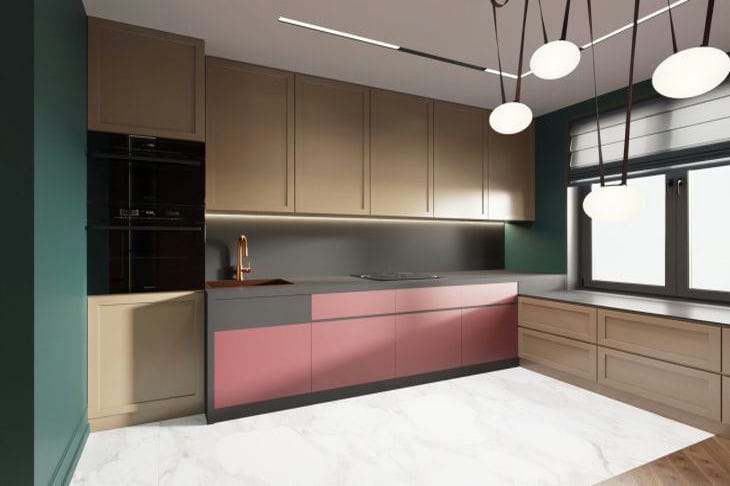When preparing for a kitchen renovation, it is worth considering the advantages of all materials: wood, concrete, resin, natural stone, tiles. Which of them is the most durable?
They say that kitchens are the heart of the home. Most of the family life takes place here, so the floors should be practical, but also aesthetic.
Both the walls and the floor must be resistant to water, dirt, damage and frequent washing, says Yulia Tychino .
The selected materials must also be insensitive to the influence of microclimatic conditions - humidity and temperature.
What tiles to choose for the kitchen floor
A classic of the genre - ceramic floor tiles for the kitchen. It stands out among other solutions due to its high durability.

Due to low water absorption and resistance to dirt, floors are most often made of porcelain stoneware and glazed porcelain stoneware.
Clinker and terracotta have similar properties, but they are more prone to crushing and destruction.
Kitchen floor tiles have many advantages, but they are not the easiest to install. In addition, the surface of this material is cold to the touch and relatively noisy to use.
Stone floor in the kitchen
Kitchen floors are also often made of natural stone, which does not absorb moisture and is resistant to abrasion.
These include granite, slate and travertine, although the latter is difficult to keep clean due to its porous structure.
In addition to natural raw materials, you can also choose from conglomerates, most commonly granite and quartz.
It is not recommended to use limestone, sandstone and marble, which absorb water and become discolored when in contact with acidic substances - vinegar or lemon juice. In order for the stone floor to remain in good condition for a long time, it requires impregnation and polishing.
Natural stone flooring feels cool to the touch. Tiles are usually larger in size than ceramics. They use thinner joints, which is a big advantage.
The price of this type of finishing may be a limiting factor, often higher than that of ceramic tiles.
Concrete on the kitchen floor
Architectural concrete is a material that is perfect for kitchens in the style of minimalism, modernism and loft. It is laid on the floor in the form of slabs or seamless screed.
It requires impregnation or protection with varnish, which makes it resistant to water and mechanical damage. Over time, cracks and scratches may appear on it.
Laying a concrete floor is labor-intensive and expensive - it requires hiring specialists.
Wooden floor in the kitchen
Wood is synonymous with style. Used on the floor, it will add class and character to the kitchen.
However, for many reasons, it is not the most popular flooring option for this room.
Natural raw materials are expensive, susceptible to moisture and deformation, and require regular maintenance - lubrication, which must be repeated even every few months.
Another way to protect a wooden floor is to varnish it, which preserves the natural look and makes minor damage difficult to repair. Use hardwoods such as beech, maple, oak, and ash for the kitchen.
Kitchen Floor Panels
An interesting choice for the kitchen are panels - available in many options: wooden, laminated and vinyl. Their advantage is an attractive price and ease of execution.
Wooden floor panels in the kitchen
Wooden panels do not require sanding and do not deform under the influence of humid air or high temperatures. Their disadvantage is the way they are made.
The absence of a protective layer of varnish on the joints, which exposes them to moisture and damage at the edges.
Kitchen floor panels - laminate
Laminated panels are generally resistant to dirt and mechanical damage. They also do not fade under the influence of sunlight. They are easy to install and easy to keep clean.
For the kitchen, it is recommended to choose models with additional protection that guarantees water resistance. It is also worth paying attention to high abrasion classes.
Laminate flooring itself is not soundproof, so if you want your floor to be quiet, use soundproofing mats underneath.
Kitchen panels - vinyl
Vinyl panels do not have such problems - they are resistant to moisture and water (they can also be installed in the bathroom), easy to maintain, scratch-resistant and are definitely quieter than non-resilient laminate.
Their higher price is offset by the high durability of this type of finish. They are installed in a floating or glued to a ground system. The second option is definitely more difficult to remove.
Cork flooring in the kitchen
A durable and flexible option is cork flooring in the kitchen. This material is similar in properties to wood. It insulates heat well, so it can reduce bills.
However, this same feature makes it unsuitable for underfloor heating systems.
It also dampens sounds and tolerates moisture well - provided it is properly secured. It does not warp under the impact of heavy weights.
Cork kitchen cladding must be protected with polyurethane varnish or vinyl coating.
Kitchen flooring - PVC
PVC flooring is a cheaper alternative to laminate, vinyl panels and cork flooring. It is a great material if you are planning a quick and easy renovation.
It is enough to install it directly on the old floor. Its choice is supported by practical advantages - resistance to greasy dirt, moisture and abrasion (usually thicker cladding is chosen for the kitchen).
Kitchen flooring - terrazzo
Terrazzo, an engineered stone that is a mixture of cement, aggregate and pigments, is becoming increasingly popular.
It used to be associated with a grey mass with dark spots, but now manufacturers are outdoing each other in creating interesting and unique colour combinations.
Instead of grey spots, large colour spots appear. Terrazzo can be laid in the form of slabs or screeds, which allows for a seamless effect and, unfortunately, increases the cost of making such a floor.
The floor in the kitchen is rubber
Natural and synthetic rubber is an extremely interesting solution for kitchen flooring. It is available in many colors that can be combined with each other. It is scratch-resistant and very durable.
Earlier we talked about the features of arranging a living room .









